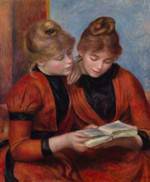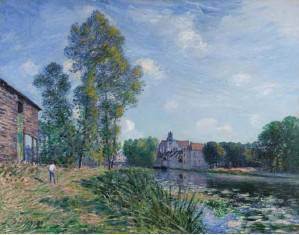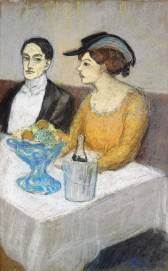
Pierre-Auguste Renoir, Les Deux Soeurs, est: £ 6-8 million

Alfred Sisley’s Le Loing à Moret, en été of 1891

Pablo Picasso’s Homme et femme à table: Angel Fernández de Soto et son amie
Impressionist and modern Art at Sotheby’s London, February 2007 Impressionist and modern Art evening auction at Sotheby’s London, February 2007, featuring important works by Renoir, Picasso, Monet, and others]]>
February 2007, source: Sotheby’s
Sotheby’s sale of Impressionist and Modern works of art on the evening of Monday, February 5, 2007 will include major works by nearly all the leading names in the field – among them Sisley, Degas, Renoir, Pissarro, Cézanne, Dufy, Gauguin, Modigliani, Léger, Vlaminck, Picasso and Soutine. Not only do these works provide a remarkably complete overview of one of the most fertile and fascinating periods in art history, but – together with the other elements of the series – they also carry a combined estimate in excess of £100 million, making this the highest value series of sales Sotheby’s has ever staged in Europe. Another notable feature of February’s Evening sale is that many of the works to be offered have not been seen on the market for many years; in particular the important groups from three distinguished private collections: Haas, Lachman and Singer. Alongside the Impressionist and Modern works, the Evening sale also comprises sales of German & Austrian, and Surrealist art.
At the core of the sale are three masterworks from the collection of the late Charles R. Lachman, a founding partner of Revlon, one of the world’s most successful cosmetic companies. Mr Lachman acquired the paintings – by Renoir, Vlaminck and Dufy – in the 1950s and so all are completely fresh to the market. They are also each a tour-de-force of rich colour and as such reflect the profound sensitivity to colour – especially red – that provided a key element in Mr Lachman’s success as a businessman. Renoir’s Les Deux Soeurs, estimated at £6,000,000-8,000,000, is a highly accomplished work and by every measure, a benchmark of Impressionist portraiture. Similarly Maurice de Vlaminck’s Symphonie en couleurs (Fleurs) of 1905 (est: £1,500,000-2,500,000/$3,710,000-4,930,000) resonates with the passion and exuberance that characterise the greatest Fauve paintings, while Raoul Dufy’s La Foire aux Oignons (est: £1,200,000-1,800,000/$2,380,000-3,550,000) of 1907 is a powerful and monumental work from the apex of the fauve movement.
Claude Monet’s Maison du Jardinier or Bordighera, La Méditerranée (est: £2,500,000-3,500,000/ US$ 4,930,000-6,900,000/ €3,710,000-5,190,000) explores the core Impressionist themes of light and time. It is one of a group of pictures that Monet painted in Italy which anticipate the much more formally connected series of paintings that dominated his later career.
Painted a decade later, in 1894, Paul Gauguin’s Ferme en Bretagne II (illustrated right, est: £2,500,000–3,500,000 / US$ 4,930,000-6,900,000 / €3,710,000-5,190,000) explores a very different landscape theme, demonstrating a powerful and forward-looking fascination with the primitive. Gauguin first went to Brittany in 1886, seeking a simple way of life in a part of France virtually untouched by the effects of progress, and returned there in 1894 prior to his second Tahitian journey. During this last stay in France, the oils he executed show the influence of his first trip to Tahiti – reflected here in the strong, vibrant colours and the increased interest in nature, echoing the wild vegetation of the South Seas. In both Brittany and Tahiti, he found similar resonances: in a letter to a friend, he wrote “I love Brittany, which I find savage and primitive. When my clogs ring on the granite ground, I hear the dull and powerful sound that I am looking for in painting.”
Edgar Degas’ Trois danseuses jupes violettes of 1898 – a work which lies at the heart of the Impressionist movement and its fascination with themes from theatre and dance. Estimated at £4,000,000–6,000,000 (US$ 7,890,000-11,830,000/€5,930,000-8,890,000), it is one of the artist’s finest pastels from the 1890s. Degas’ lifelong interest in dance developed in the 1860s, when as a young man he regularly attended the ballet and other performances such as opera, café-concerts and the circus. He found in the spectacle and excitement of live entertainment an endless source of inspiration, sketching the performers from nature. Characteristic of his later pastels, this work shows a shift of focus away from the linear, towards a new interest in colour, allowing the artist to transform a ballet scene into a firework display of strong, bright colours.
Just as in the case of the Degas, colour is at the heart of Chaïm Soutine’s L’Homme au Foulard Rouge of around 1921, but here it is used to completely different effect, generating an energy and expressive force that characterises the artist’s most accomplished portraits. Estimated at £3,500,000–5,000,000 (US$5,900,000 – 9,860,000 / €5,190,000 – 7,410,000), the work has been consigned for sale by Mrs Wendell Cherry. Rich in masterpieces, the Cherry collection also contained the extraordinary Modigliani, Jeanne Hebuterne, (Devant une porte), which sold at Sotheby’s New York in November 2004 for $31.36 million – still the auction record for the artist.
The Collection of Paul and Mary Haas: Cézanne, Sisley, Monet, Caillebotte
Pictures from distinguished American collections feature strongly in the sale. Best known for their philanthropic support of educational causes, Paul and Mary Haas, of Corpus Christi, Texas were also, for many years, discreet and discerning collectors who amassed a group of extraordinary works, each of which reveals a different chapter of the journey of Impressionism: from its roots in plein air painting, through the maîtres of the ground-breaking exhibitions of 1874 -1886, to the singular new directions that characterised the fin-de-siècle. Like that of Lachman, the Haas collection was also formed in the 1950s.
One of the works in the Haas collection is Paul Cézanne’s Entrée de ferme, rue Rémy, à Auvers-sur-Oise an important work, painted in 1873 – a pivotal year in the artist’s development. With its free, spontaneous brushwork and sun-filled colours, this fine landscape anticipates the artist’s later style. The painting’s first owner was none other than Camille Pissarro, who was Cézanne’s great friend and mentor at the time, and under whose influence and guidance Cézanne first started painting from nature. The work is estimated at £1,500,000-2,000,000 (€2,230,000 – 2,970,000 / $2,960,000-3,950,000)
A second work from the Haas collection shows another artist, Claude Monet, at an important turning point. Estimated at £750,000-1,000,000 (US$ 1,480,000 – 1,980,000 / €1,120,000 – 1,490,000), Eglise de Vétheuil of 1878 shows the artist fragmenting forms in anticipation of his later, almost abstract, masterpieces.
One of his most enchanting compositions, Alfred Sisley’s Le Loing à Moret, en été of 1891 was painted in the last decade of the artist’s life, when the quietness of beauty of the town of Moret on the Seine became an important source of inspiration. Estimated at £1,800,000-2,500,000 (US$ 3,550,000 – 4,930,000/€2,670,000 – 3,710,000), this glorious landscape shows Sisley at his best, recording the changing play of sunlight on the water, with juxtaposed brushstrokes of bright yellow, green and purple tones capturing the shifting effect of sunlight and shadows.
The Singer Collection: Archipenko, Arp, Lipchitz and Modigliani
A third major collection comes from the estate of Herbert and Nell Singer. Herbert Singer was a successful New York lawyer and, together with his wife Nell, a noted philanthropist. Portrait du peintre Rouveyre (est: £1,400,000-1,800,000/$2,760,000-3,550,000/€2,080,000-2,670,000-3,550,000) is a powerful example of Amedeo Modigliani’s early portraiture, dating from the pivotal period in the artist’s career when he was living in Montparnasse. The sitter was a well-known figure in Parisian artistic circles of this period, associated with the avant-garde artistic community that developed in Montparnasse.
The Singer collection is particularly rich in sculpture, and includes an elegiac stone sculpture Tête (£600,000-800,000/$1,190,000-1,580,000/€890,000-1,190,000), also by Modigliani, which displays a remarkable richness of surface treatment, juxtaposing the elegant facial features and the roughly chiselled hair. This technique reflects an amalgamation of influences that played an important role in the artist’s development as a sculptor, from dance masks from the Ivory Coast and Khmer sculpture to ancient Egyptian and Greek art.
Among other sculptures in the collection are bronzes by Jacques Lipchitz, Sailor with Guitar (est: £400,000-£600,000/US$790,000-1,190,000/€595,000-890,000), Alexander Archipenko (Head: Construction with Crossing Planes est: £100,000-150,000/US$198,000-296,000/€149,000-223,000) and Jean Arp (Sculpture Classsique, est: £300,000-400,000/US$595,000/790,000/€445,000-595,000).
From another distinguished private collection: Bonnard, Morandi, Boudin, Fantin-Latour
Four more in works in the sale come fresh to the market, having been part of another distinguished private collection for more than 20 years. Among these is a rare example of Pierre Bonnard’s treatment of the theme of ballet. From 1909 onwards, Bonnard was a regular visitor to Serge Diaghilev’s Ballets Russes, and in Danseurs (£800,000-1,200,000/US$ 1,580,000-2,370,000/€1,190,000-1,780,000) he conveys his deep fascination with the spectacle that featured both the celebrated dancer Nijinsky, and the exuberant and exotic costumes of Leon Bakst. The other works from this collection are Eugène Boudin’s Trouville. Crinolines et Cabines (est: £300,000-400,000/US$595,000-790,000/€445,000-595,000), Giorgio Morandi’s Natura Morta (est: £350,000-450,000/US$690,000-890,000/€520,000-670,000) and Henri Fantin-Latour’s Roses trémières (est : £500,000-700,000/US$990,000-1,380,000/€745,000-1,040,000).
Finally, from a different source, Pablo Picasso’s Homme et femme à table: Angel Fernández de Soto et son amie (est: £1,800,000-2,500,000US$3,550,000-4,930,000/€2,670,000-3,710,000) is an outstanding watercolour of 1902-3 – the artist’s celebrated Blue period. The male figure, pictured with an unknown female companion, is Angel Fernández de Soto, whom Picasso met in Barcelona in 1899. Café scenes had strong resonance for the young Picasso, who frequented Els Quatre Gats in Barcelona with a bohemian circle of friends, including de Soto, while also experiencing the nightlife of Paris during his visits to the metropolis. Angel became one of Picasso’s closest allies during this time: the two shared a studio in Barcelona, and, although Picasso settled in Paris shortly afterwards, the two friends remained close until 1938 when Angel was killed in the Spanish Civil War.
Follow us on:


